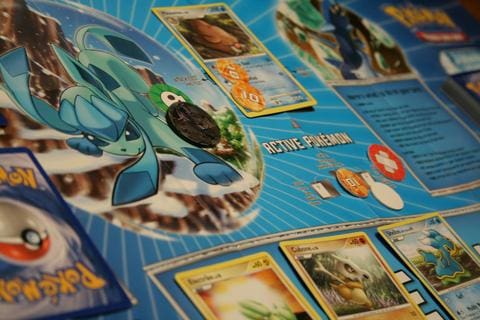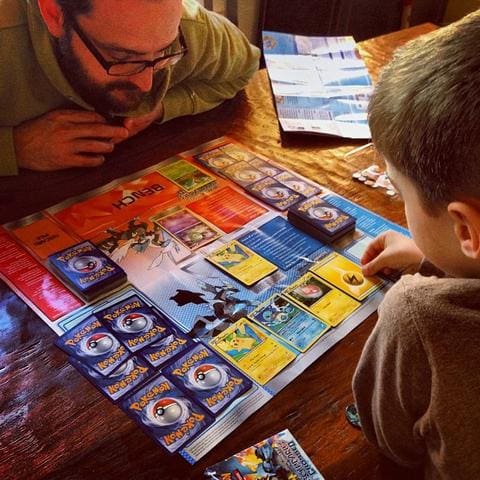How to Improve Your Pokémon TCG Strategy
Pokémon TCG, Photo Cred / Jinx!
Pokémon has managed to strike a unique blend of both deep, highly complex strategy, and simple game mechanics which creates a game that can be enjoyed by players of all ages; and skill levels. This has led to a thriving community in which there is plenty of competition. The competition is fierce however, and you may find that other players are able to beat you more often than not. If that’s the case, read on as this guide will teach you how to become a better Pokémon TCG player.
Before we dive into the guide it’s important to note that this guide isn’t going to teach you how to build a deck, but instead how to fully unleash the potential of your deck. Both deck building and game strategy are important to being competitive in the hobby, and if you’re new, you can start with this guide or our Pokémon TCG deck building guide.
General Tips to Keep in Mind
We’ll start with some general gameplay and strategy tips.
First, you need to understand your deck’s resources. Memorize the number of different cards in your deck. Do you have a low number of energy cards? A low number of Pokémon? These are important bits to know as they’ll impact the way you play the game. For example, a low number of energy cards may mean that it’s better to lose a Pokémon and have you opponent draw a prize card than retreat that Pokémon at the cost of 2 energy.
Second, you’ll need to understand your deck’s combinations, knowing both how and when to use them. Combos in Pokémon TCG are powerful sets of cards that when played together create a devastating turn. A well-played combination of cards can have the potential to turn the tide of a game in a single turn, but at a cost. In order to unleash that combination, you may need to wait to draw the other cards. This is where the next point comes in.
The third tip I’ll share with you is how and when to use your trainer cards. Trainer cards primarily have 3 functions:
- To help you draw more cards.
- To help you deal more damage, or mitigate damage.
- To disrupt enemy combos and strategies.
It’s crucial to know when and how to do those 3 things. For drawing cards, you’ll generally want to use these as often as possible. The more cards in your hand the more chances you have a stringing together powerful combos. However, there are only two times when you’ll want to avoid drawing cards.
First, when your opponent has a trainer card which works when you have a large hand. And secondly, when you have a trainer card that works when you have a small hand.
Next, you’ll want to know how to deal and mitigate damage. Currently, most decks revolve around dealing massive amounts of damage and wiping out your opponents. But, even though it’s a common strategy, you don’t want your opponent to know when you’re ready to unleash those large attacks. That’s why when you’re using items, stadiums, and other trainer cards that improve damage you should wait until you’re ready to attack to play them. This will prevent the enemy from disrupting your attacks and will enable you to unexpectedly release a massive attack.
If you’re focusing on mitigating damage however, you’ll want to play those types of cards sooner rather than later so that you may be able to mitigate an unexpected high damage attack.
Lastly, we’ll touch on disrupting your enemy. Disruption is one of the most powerful tactics in your arsenal; and by doing it right you can turn the tide of a game. High skill players will hide their combos and unleash them at last second, and so you’ll likely want to save your disruption cards until they have their combo lined up.
It may look complicated, but it’s actually quite simple. Photo Cred / Emmanuelle Bourgue
EarlyGame
Early game strategy: defined as the first few turns in a match, revolves more around hiding your true strategy and preventing your opponent from setting up their strategy.
One of the first tips is to avoid placing down more than 1 basic Pokémon. This has two effects:
- It makes your enemy believe that you only have 1 Pokémon, and may cause them to play differently.
- It prevents your opponent from using cards like Pokémon catcher to disrupt your strategy.
Obviously, if your first Pokémon is weak and can easily be one hit killed, you’ll want to place another Pokémon down to prevent a loss.
The next tip is to count your important cards when first searching your deck. This will enable you to know which cards are prized and which aren’t. Also, while we’re on the subject of drawing/searching: You’ll want to play your draw cards before your search cards.
This is because you may end up drawing the card you were going to search for, and it’ll enable you to use your search for a different card.
Mid-Game
During mid-game, you’ll want to keep a Pokémon with low or free retreat cost on the bench so that when your main Pokémon is knocked out, you can use the benched Pokémon to buy you some extra time.
And…. That’s pretty much it for mid game. Just make sure to keep try to keep your main Pokémon undamaged where possible.
Late Game
Late game is where things get a bit complicated. You’ll have a lot of things to consider. Once again, you’ll want to avoid placing unnecessary Pokémon on your bench as they could be used to disrupt your strategy and even become easy knock outs.
You’ll also need to be mindful of the cards in your discard pile (so that you aren’t holding out for a card that isn’t there), as well as how many cards remain in your deck. Losing as a result of having no cards to draw is never a good feeling.
Remember
One of the important things to remember about Pokémon TCG is that the winning strategies are always changing. With each new expansion, new cards and new playstyles are added. That’s why one of the biggest things you can do to improve your game is continue to read and learn. Click here to check out our list of the top 5 online places to learn about Pokémon TCG.

